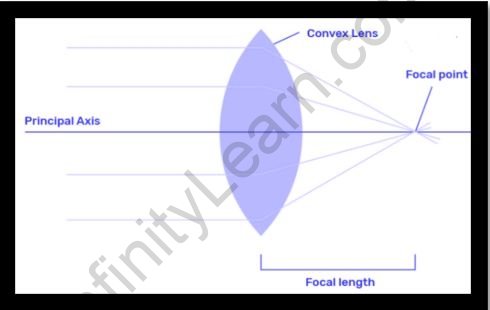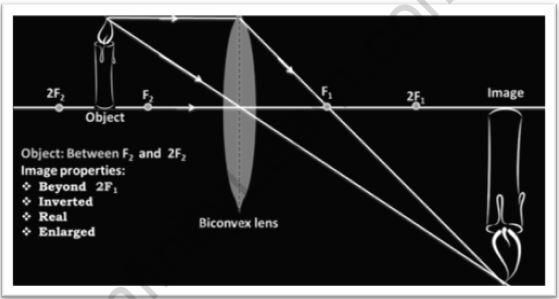
Courses

By Shailendra Singh
|
Updated on 22 Jan 2025, 12:20 IST
A lens is an optical tool or equipment that, through refraction, tends to both converge and diverge a beam of light. A simple lens is often made up of just one piece of transparent material, where as a compound lens is made up of numerous simple lenses aligned along a common axis.
A convex lens converges light beams that travel parallel to its primary axis, which is comparatively thick in the center and thin at the lower and higher ends. Rather than curving inward, the edges curve outward. It is placed in front of the eye to sharply bend incoming light, causing the focal point to shorten and the light to focus properly on the retina.
A convex lens can generally converge a stream of parallel rays to a spot on the other side of the lens. This point is called the lens’ focus, and the focal length is the distance between it and the Optical Centre of the beam.
An approximate equation connects the radius of curvature R1 and R2 of the spherical surfaces and the focal length of the lens ‘f’. The focal length of a Double Convex Lens is wider attributed to the prevalence of a second curved surface. Dual Convex Lenses are popular because many optical devices demand extended focal lengths.

Image of the Real: When an object is positioned at a distance of more than one focal length from the lens, a convex lens can be utilized to provide a genuine image. It can be flashed at the front of the lens and captured on a screen. It’s found in movie theatres, projectors, and other places.
Image of the virtual: If the object is in front of the focal point, a virtual image will be produced by a convex lens. It is exploited to give crisp images in eyewear.
Formula:

1/f = 1/v + 1/u
Where
f = focal length.
v = the distance of the image from the optical centre.
u = the distance of the object from the optical centre
In convex lenses, the focal length is positive.

When looking through a convex lens, the image generated is always at a place where at least two refracted light rays tend to meet.
The following are the rules for creating an image with a convex lens:
Rule 3: When a beam of light passes through the focus of a convex lens, refraction occurs, and the ray becomes parallel to the primary axis of the lens.
Convex lens magnification is characterized as the proportion of picture tallness to protest stature. Amplification of 2 implies that the image is double the size of the item, though amplification of 1 implies that the picture is a similar size as the article.
At the point when the amplification is positive, the image is vertical corresponding to the item (virtual picture). The image is switched in contrast with the item when amplification is negative (real picture).

The following are some of the applications:
Every year, the oscillation and waves unit is typically asked 4 to 5 questions in the IIT JEE exam. Attempt to comprehend complex issues such as the theory of superposition, wave reflection and refraction, light reflection and refraction, and lenses.
It will not only make it easier for you to understand the concepts, but it will also aid in their retention for a longer period of time. In this topic, there were 10 easy questions, 17 intermediate questions, and 3 difficult questions.
Because it conforms to a parallel light beam on a point considered the principal focus, a convex lens is termed a converging lens.
According to the Cartesian sign convention, item distances (u) have always been negative when the object is placed to the left of the mirror/lens. The focal length of a convex lens and convex mirror is positive (f). The focal length of concave lenses and concave mirrors is negative.
They're accessible in a range of shapes and sizes. Plano-convex lenses, double convex lenses, and concave-convex lenses are the three types of these lenses.